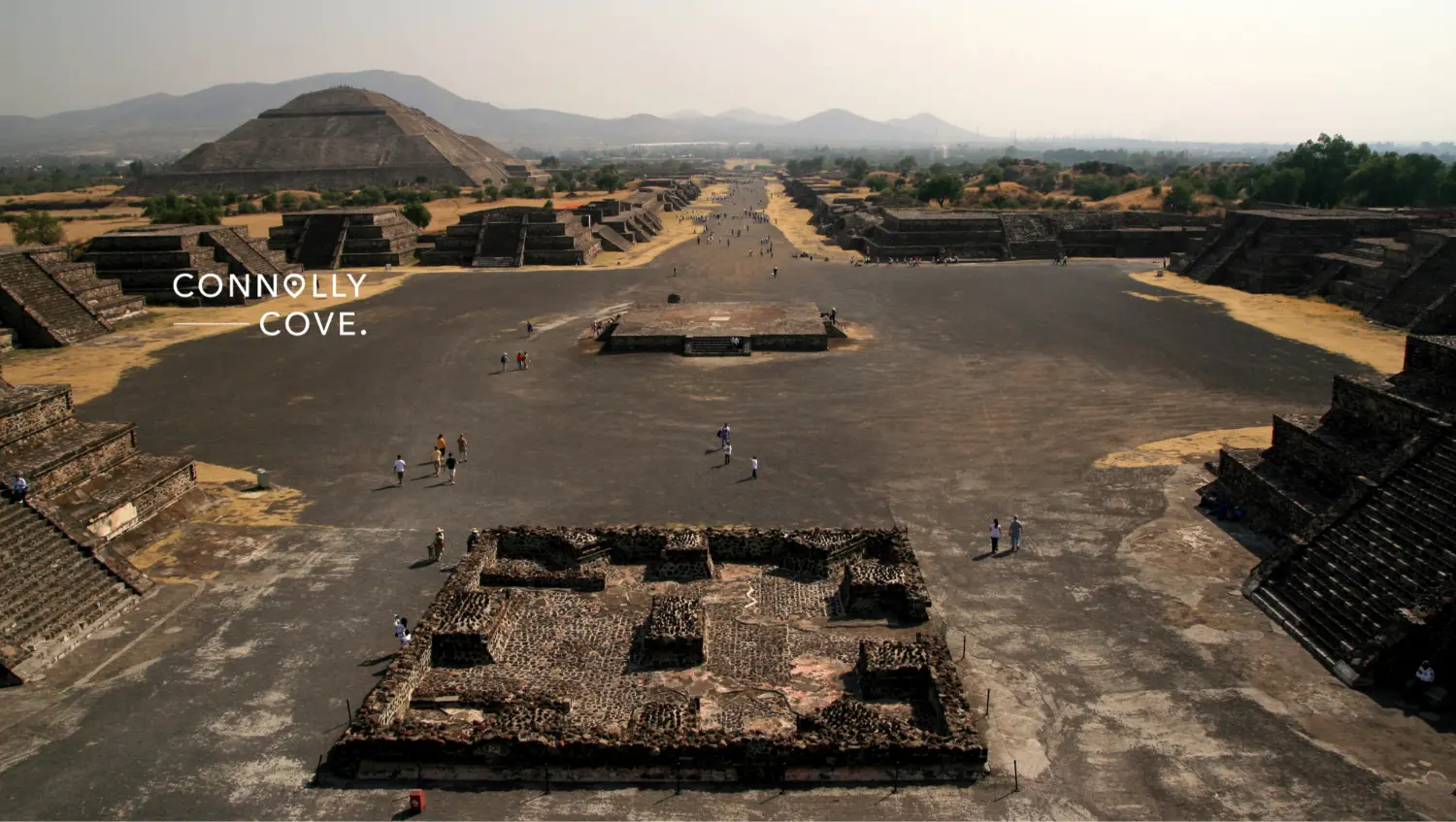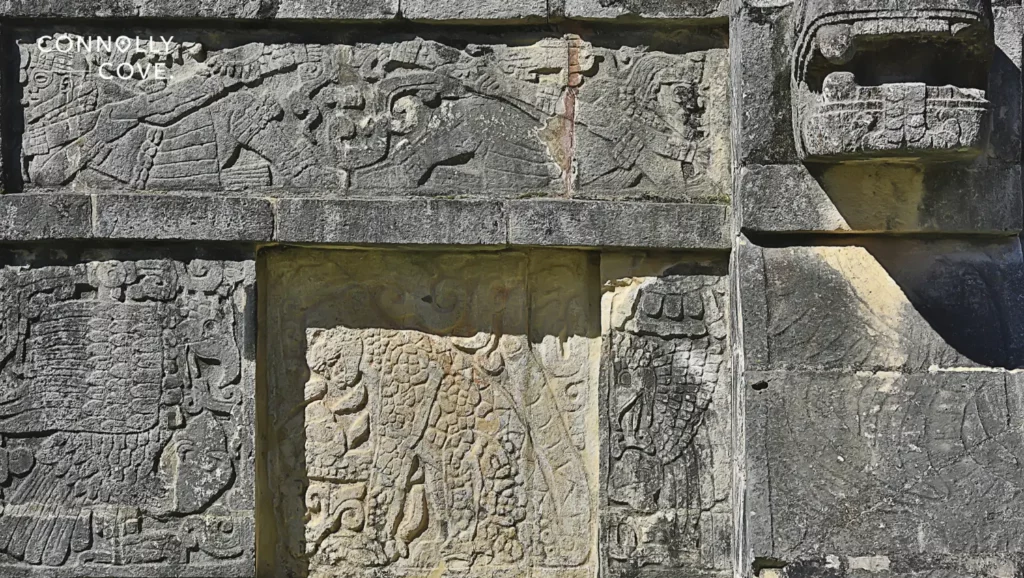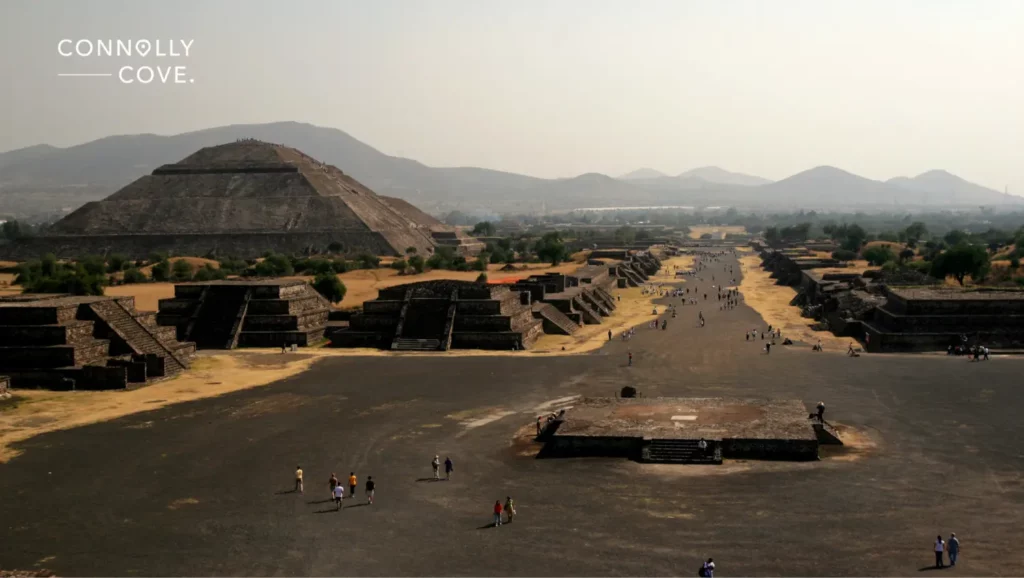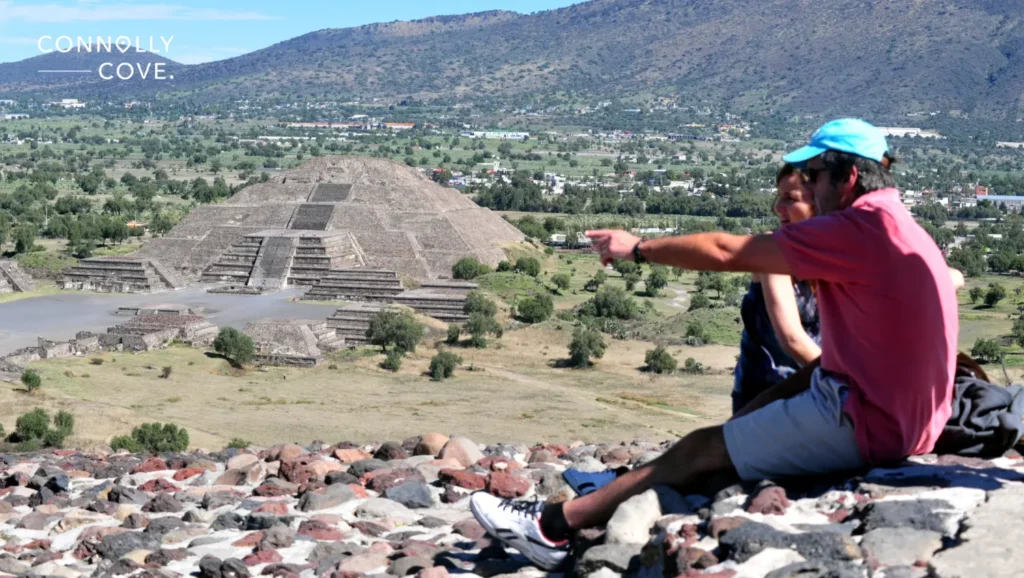Mesoamerican Pyramids: A Window to the Ancient World

Updated On: April 30, 2024 by Noha Basiouny
The mysterious allure of ancient Mesoamerican pyramids stands as a monumental testament to the rich and enigmatic history of Mesoamerican civilisations that flourished long before the modern era. Rising majestically against the backdrop of lush landscapes and blue skies, these architectural marvels, rooted deeply in the cultural and spiritual fabric of pre-Columbian societies, continue to captivate archaeologists, historians, and travellers alike.
This article dives into the world of these magnificent structures, exploring their historical significance, architectural brilliance, and the enduring mysteries they hold. From the towering Pyramid of the Sun at Teotihuacan to the enigmatic Castillo at Chichen Itza, each pyramid tells a story of the people who built them, the gods they worshipped, and the astronomical knowledge they possessed.
As we journey through the heart of Mexico and Central America’s cities, we uncover the secrets of these pyramids, shedding light on the advanced civilisations that once thrived in this land.
Mesoamerican Civilisation
Mesoamerica is a historical region that used to extend approximately from central Mexico down through Central America, precisely into what is now Guatemala, Belize, Honduras, El Salvador, Nicaragua, and Costa Rica. For thousands of years, multiple civilisations flourished either simultaneously or consecutively in this area. Each of these civilisations developed their unique culture, political systems, and achievements, and they are all collectively known as Mesoamerican civilisation.
Unlike Egyptian civilisation, which has a start and end estimation, it is not known when or what made Mesoamerican civilisation start nor when it ended due to its vast temporal and geographical span. However, scholars have decided to divide it into three main periods, each marked by distinct developments in society, culture, and politics:
- Preclassic Period (2000 BC-250 AD): This era witnessed the rise of communities, the cultivation of crops, the formation of social hierarchy, and the development of politics, as well as early Mesoamerican writing and calendar systems. Civilisations that flourished in this period were the Olmecs (1500-350 BC), the Mayans (1500 BC-900 AD), and the Zapotecs (500 BC-1521 AD).
- Classic Period (250-900 AD): This phase is marked by the height of cultural and political development and is known as the golden age of the Maya civilisation. This civilisation is noted for its cities, mostly notably the city of Teotihuacan, step pyramids, and advancements in writing, mathematics, and astronomy.
- Postclassic Period (900–1521 AD): Marking the final era of pre-Columbian civilisations in the region, this period was characterised by significant political, social, and cultural transformations and the development of complex trade networks. Some civilisations that prospered during this time include the Toltecs (950-1150 AD), the Aztecs (1300-1521 AD), the Tarascans (1100 to 1530 AD), the Mixtecs (1500-1521 AD).
The arrival of the Spanish conquistadors in the early 16th century marked the end of the Postclassic period and the beginning of a new era for Mesoamerica.
Mesoamerican Pyramids
Mesoamerican civilisations, thus, are central to understanding the pre-Columbian history of the Americas and have left a lasting impact on the region’s cultural, architectural, and historical landscape. They are best renowned for their architectural achievements, including temples, palaces, and ballcourts, but most notably, pyramids.
So yes, ancient Egyptians were the first to build pyramids, but not the only civilisation that did so. Nubians, as in the people who established Nubian civilisation in what is now Sudan, built beautiful, yet smaller, pyramids than their Egyptian counterparts. Mesoamerican, too, built pyramids, majestically distinct stepped pyramids.
While ancient Egyptians and Nubians alike built pyramids for the burial of the royals, Mesoamericans built theirs for several other reasons that reflect their cultural, religious, and societal values, which also somewhat highlight their significance:
- Religious and Ceremonial Purposes: Mesoamerican pyramids often housed temples on their summits where priests performed rituals, offerings, and sometimes human sacrifices to the gods. These structures were seen as a connection between the earth and the divine realm, making them central to religious practices.
- Astronomical and Cosmological Significance: Many Mesoamerican pyramids were aligned with astronomical events, like equinoxes and solstices. This reflects the Mesoamericans’ advanced understanding of astronomy and its integration into their cosmology.
- Political and Social Power: Building a pyramid was a demonstration of a ruler’s power and resources. It served as a physical manifestation of a ruler’s ability to mobilise labour, manage resources, and maintain control. In this way, pyramids were symbols of political authority and legitimacy.
- Cultural and Artistic Expression: Mesoamerican Pyramids also served as canvases for artistic expression. Many were adorned with carvings, murals, and sculptures that depicted gods, rulers, mythological scenes, and important historical events. This art served both religious functions and as a means to propagate state ideology.

Sites
Providing an exact count of all Mesoamerican pyramids is challenging due to several factors, such as the vast geographical spread of these structures across several countries, the ongoing discovery of new sites by archaeologists, and the fact that many ancient pyramids remain unexcavated or were repurposed over time.
Along with that, some structures might not be classified strictly as pyramids, such as ceremonial platforms or temple mounds, although they share similarities with pyramid structures.
However, there are numerous well-known and significant pyramid sites across the Mesoamerican region, standing out for their historical significance, architectural grandeur, and cultural importance. Most of them are located in modern-day Mexico, Guatemala, Belize, Honduras, and El Salvador.
These regions were the heartlands of various ancient Mesoamerican civilisations that built these impressive structures. The distribution of these pyramids reflects the geographical reach and cultural influence of these civilisations:
Mexico

Mexico is home to the majority of Mesoamerican pyramids, reflecting the country’s role as the centre of several vital civilisations such as the Olmecs, Mayans, Zapotecs, Toltecs, and Aztecs. Here are some of the most famous pyramid sites in Mexico.
- Teotihuacan: Known for the massive Pyramid of the Sun and the Pyramid of the Moon, this ancient city is one of the largest and most significant archaeological sites in Mexico.
- Palenque: Famous for its exquisite architecture and art, Palenque is home to the Temple of the Inscriptions, the burial site of the Maya ruler Pakal.
- Uxmal: This site features the Pyramid of the Magician, unique due to its rounded sides, steep slope, and unusual elliptical base.
- Monte Albán: A significant Zapotec and Mixtec site, this one is known for its large plaza surrounded by temples and other Mesoamerican pyramids.
- El Tajín: Renowned for the Pyramid of the Niches, this site is a testament to the architectural ingenuity of the Totonac people.
- Calakmul: Located deep in the jungles of the Yucatán Peninsula, this Maya site is home to one of the largest Mesoamerican pyramids by volume.
Guatemala
Guatemala used to be a significant centre for the Maya civilisation, featuring numerous pyramid complexes. Some of the most famous Mesoamerican pyramids there include those found in Tikal, one of the biggest archaeological sites and most significant urban centres of the pre-Columbian Maya civilisation.
The Tikal National Park in northern Guatemala is home to a number of these structures, renowned for their towering pyramids and temples, including Temple I, also known as Temple of the Great Jaguar, and Temple IV, one of the tallest pre-Columbian structures in the Americas, both offering breathtaking views of the surrounding rainforest.
Other notable sites in Guatemala with Mesoamerican pyramids include El Mirador, known for its massive size and significant influence in the Maya world, and Yaxha, a classic period Maya site located between the larger sites of Tikal and Calakmul.
Honduras
Located in Central America to the southeast of Guatemala, Honduras is home to several important archaeological sites featuring pyramids. The most famous and significant of these is Copán, located in the western part of the country near the border with Guatemala.
Copán was one of the most important cities of the Maya civilisation during the Classic period. The site is renowned for its beautifully carved stelae and altars, intricate hieroglyphics, and its impressive series of step pyramids and other ceremonial structures.
The main pyramid at Copán, known as the Hieroglyphic Stairway Temple, features one of the longest-known Maya hieroglyphic texts and provides invaluable insights into the history and culture of the ancient Maya. The Acropolis, another key structure at the site, contains a complex of royal palaces and a series of terraces and pyramids.
Architectural Marvels
Mesoamerican pyramids showcase a variety of sophisticated architectural features that highlight the advanced engineering skills of their builders. These structures were not just monumental in scale but also complex in design and construction, reflecting a deep understanding of mathematics, geometry, and astronomy.
Here are some key architectural features of these majestic structures:
- Stepped Design: Most Mesoamerican pyramids are characterised by their stepped, tiered sides. These steps often lead to a temple at the top. The stepped design not only provided a functional approach to the summit but also symbolised various cosmological and religious concepts.
- Stairways: Most Mesoamerican pyramids have one or more stairways leading to the top. These stairways are often wide and centrally located. They were not just functional but also held ceremonial significance.
- Flat Tops with Temples: Unlike the pyramids of Egypt, which taper to a point, Mesoamerican pyramids typically have flat tops that often-housed temples or altars. These temples were central to religious ceremonies and rituals, making the pyramid not just a monumental structure but a functional religious centre.
- Plazas and Courtyards: Mesoamerican pyramids were often part of a larger ceremonial complex that included plazas, courtyards, and other buildings. These spaces were used for public ceremonies, markets, and social gatherings.
- Decorative Elements: Many pyramids featured intricate carvings, stucco work, and sculptures. These decorative elements often depicted gods, mythological creatures, and scenes of religious significance.
- Astronomical Alignments: Many pyramids were precisely aligned with celestial bodies and events, such as solstices and equinoxes. The Pyramid of Kukulkan at Chichen Itza, for example, is famous for the serpent-like shadow that appears on its steps during the equinoxes.
Construction
The construction of Mesoamerican pyramids is a testament to the ingenuity, skill, and organisation of ancient Mesoamerican societies, an impressive feat showcasing the advanced engineering of the ancient builders.
Here is an overview of the process and techniques involved:
Planning and Design
First and foremost, a site for the pyramid needed to be determined. Choosing a location often involved astronomical considerations, ensuring alignment with celestial events. Builders then planned the pyramid’s dimensions and layout, often incorporating symbolic and religious elements.
Foundation and Core Construction
A strong foundation was crucial, especially in regions prone to earthquakes. This often involved levelling the ground and creating a stable base. The core of the pyramid was typically made of earth, rubble, or less finely cut stones, which were then covered with more refined materials.
Facing and Platforms
Stones were quarried, shaped, and transported to the site. The precision in stone cutting demonstrates advanced knowledge in geometry and masonry. Pyramids were primarily constructed from locally available materials, such as limestone, sandstone, and volcanic rock.
As we just mentioned, the core was often made of rubble, which was then faced with cut stone. The use of mortar was common in some areas, while in others, stones were precisely cut to fit together without it.
Mesoamerican pyramids often had multiple platforms or levels, each requiring careful construction to support the weight above.
Labour and Organisation
The construction of a pyramid required a large workforce, including skilled artisans, labourers, and engineers. This suggests a well-organised society with the ability to mobilise and support large groups of workers.
Large pyramids were often built in phases over many years or even centuries, with later generations adding to or modifying existing structures.
Acoustics and Sound Engineering
Some pyramids, like the Pyramid of Kukulkan, demonstrate sophisticated acoustic properties. Clapping at the base of the steps creates an echo that resembles the chirp of the sacred Quetzal bird.
Largest and Smallest
The largest Mesoamerican pyramid by volume is the Great Pyramid of Cholula, also known as Tlachihualtepetl—do not try to pronounce it!
Located in Cholula, Puebla, Mexico, the Great Pyramid has the largest base of any pyramid in the world, covering approximately 400 by 400 metres. It stands at about 55 metres tall, and its total volume is estimated to be over 4.45 million cubic metres, making it larger than the Great Pyramid of Giza in terms of volume, although it is not as tall.
The Great Pyramid was constructed in multiple phases starting from the third century BC and continued to be built over a period of more than a thousand years. That is why it reflects a mix of architectural styles influenced by various cultures, including the Olmecs, Toltecs, and Aztecs.
Today, much of the pyramid is covered with vegetation, making it resemble a natural hill more than a pyramid. On top, there is a Spanish colonial church, that is the Iglesia de Nuestra Señora de los Remedios, built in the 16th century.
Having said that, determining the smallest Mesoamerican pyramid is challenging due to the vast number of pyramids built across different eras and cultures in Mesoamerica. Many smaller pyramids may not be well-documented, excavated, or as famous as their larger counterparts. However, there are smaller pyramids known for their specific historical or cultural significance, such as:
- Pyramids at Tulum: The Maya site of Tulum, located right on the east coast of the Yucatán Peninsula in Mexico, has several smaller-scale pyramids and structures. These are not as large or tall as the pyramids found in sites like Tikal or Chichen Itza but are significant for their coastal location and well-preserved state.
- Minor Pyramids in Larger Complexes: In major archaeological sites like Teotihuacan, Tikal, or Monte Albán, there are often smaller subsidiary pyramids surrounding the larger, more central ones. These smaller structures could have served various purposes, including astronomical observations, secondary temples, or altars.
Tourist Experience

Visiting Mesoamerican pyramids can be a fascinating and enriching experience that allows you to connect with the fascinating history and culture of the region. However, it is essential to plan your trip thoughtfully to make the most of your visit while respecting the historical and cultural significance of these sites. Here are some tips for tourists wishing to visit Mesoamerican pyramids:
- Research and Planning: Research the specific pyramid site you plan to visit. Understand its history, significance, and any cultural or archaeological insights. Knowing what to expect will enhance your experience.
- Best Time to Visit: The dry season (typically November to April) is by far the best time to visit Mesoamerican pyramids, as the weather is more comfortable for exploring archaeological sites. However, this can vary based on the region.
- Comfortable Clothing: Wear lightweight, breathable clothing, comfortable shoes for walking, and a wide-brimmed hat to protect yourself from the sun. Bring sunscreen and insect repellent, especially if you are visiting tropical sites.
- Hydration and Snacks: Carry a refillable water bottle and drink plenty of water, especially if the weather is hot and humid. Also, bring light snacks like energy bars or fruits to keep your energy up during your visit.
- Follow Guidelines: Observe any rules or regulations at the archaeological site, such as restrictions on climbing pyramids or entering certain areas. Be respectful of local customs and traditions. If you encounter ceremonies or rituals, maintain a respectful distance and silence.
- Photograph: Ask for permission before taking photos of individuals, especially locals, and respect any areas where photography is restricted.
- Consider a Guide: Hiring a knowledgeable local guide can significantly enhance your understanding of the site’s history and cultural significance. They can provide insights you might not find in guidebooks.
- Be Cautious: Pay attention to your surroundings, especially in less-visited or remote areas. Follow safety recommendations provided by authorities. Depending on your destination, consult a travel clinic about necessary vaccinations. Know the location of medical facilities or clinics near your chosen pyramid site.
- Souvenirs and Artefacts: Do not purchase or transport artefacts or souvenirs that may be illegal or contribute to the looting of archaeological sites. Stick to legitimate, ethically sourced items.
The pyramids of Mesoamerica stand not merely as relics of a bygone era but as enduring symbols of the ingenuity and spiritual depth of the ancient civilisations that built them. These majestic structures, etched against the backdrop of Mexico and Central America’s diverse landscapes, offer a tangible connection to the past, inviting us to ponder the complexities of human history and the timeless quest for meaning and transcendence.






